From the expansive Eastern Plains to the towering Rocky Mountains, Colorado’s diverse landscapes are a haven for birdwatchers. Embark on a vibrant journey with us as we showcase 9 exquisite red birds that grace this Centennial State.
Red Birds Found In Colorado
The varying ecosystems, from arid deserts to alpine tundras, offer niches for a plethora of bird species. With seasonal migrations, altitude-driven bird movements, and a confluence of eastern and western avian species, Colorado becomes a veritable crossroads for bird diversity.
This intricate blend of habitats and geographical positioning makes the state a birdwatcher’s paradise, offering sightings of both common and rare species, including the resplendent red avians that grace its skies and landscapes.
Northern Cardinal


| Feature | Measurement |
|---|---|
| Scientific Name | Cardinalis cardinalis |
| Length | 8.3 – 9.1 in |
| Wingspan | 9.8 – 12.2 in |
| Weight | 1.19 – 2.29 oz |
The Northern Cardinal is an iconic North American bird, easily recognized by its vibrant color and melodious song.
Appearance: Male Northern Cardinals are a brilliant scarlet red, while females display a more subdued reddish olive. Both sexes have a distinctive black ‘mask’ on their face around the bill and a pointed crest on their head. The bird’s beak is robust, cone-shaped, and bright orange in color.
Diet: Northern Cardinals are primarily granivorous, with a diet largely consisting of seeds and grains. They also eat fruits and insects. These birds typically feed off the ground and are frequent visitors to bird feeders.
Reproduction: Northern Cardinals are monogamous, and a pair will breed together for life. The female typically builds a well-hidden nest in a dense thicket or shrub. She lays 2-5 eggs per clutch, which she incubates for around two weeks.
Summer Tanager


| Feature | Measurement |
|---|---|
| Scientific Name | Piranga rubra |
| Length | 6.7 in |
| Wingspan | 28 to 30 cm |
| Weight | 29 g |
The Summer Tanager is a medium-sized songbird admired for its radiant plumage and melodious song.
Appearance: Male Summer Tanagers are an impressive bright red, while females and juveniles present a softer, yellow-orange color. Both genders have a large, slightly hooked bill and relatively short tail.
Diet: Summer Tanagers primarily feed on insects, including bees and wasps, which they catch in flight or pick off vegetation. They are also known to eat fruits and berries, making them helpful in controlling pest populations and seed dispersal.
Reproduction: The female Summer Tanager builds a loose, shallow cup-shaped nest out of twigs and grass, usually hidden in the foliage of trees. The female typically lays 3-5 eggs, which she will incubate for about two weeks.
Western Tanager

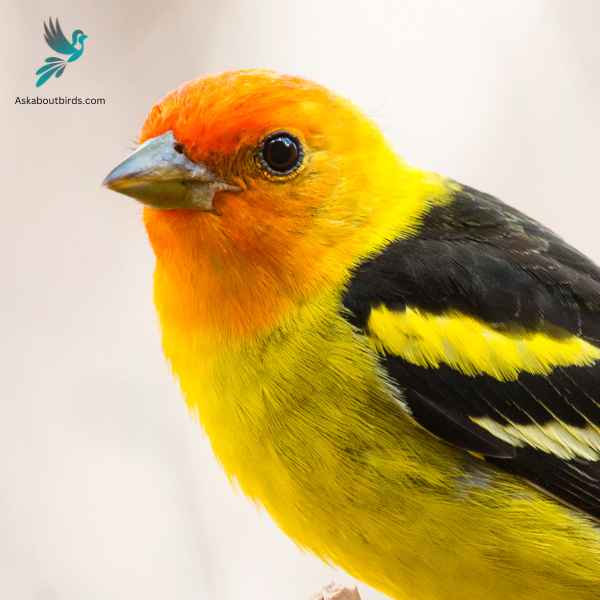
| Feature | Measurement |
|---|---|
| Scientific Name | Piranga ludoviciana |
| Length | 6.3-7.5 in |
| Wingspan | 11.5 in |
| Weight | 24-36 g |
The Western Tanager is a vibrant songbird that graces the forests and woodlands of the western regions of North America, enchanting observers with its colorful plumage and melodious song.
Appearance: The male Western Tanager is renowned for its bright yellow body contrasted with a striking red head and black wings and tail. The females are more subdued in hue, primarily being yellow with grayish wings and back, and lacking the brilliant red head of the males.
Diet: Western Tanagers primarily feed on insects, especially when breeding, but they also incorporate a significant amount of fruits and berries into their diet, especially during migration and winter.
Reproduction: Western Tanagers build their nests high in coniferous trees, often well concealed from potential predators. The female usually lays a clutch of 3 to 5 eggs and takes the primary role in incubation, while both parents are involved in feeding the chicks after they hatch.
House Finch


| Feature | Measurement |
|---|---|
| Scientific Name | Haemorhous mexicanus |
| Length | 5–6 in |
| Wingspan | 8–10 in |
| Weight | 0.6–0.9 oz |
The House Finch is a small songbird widely distributed across North America and is commonly found in urban and suburban areas.
Appearance: Males of this species are brightly colored with crimson faces and throats, which can extend to the chest and back, while their flanks have streaks. The female is streaked brown and lacks the red coloring. Both have a square-tipped tail and a distinctively long, flat-topped bill.
Diet: House Finches primarily eat seeds, grains, and berries. They have a particular fondness for sunflower seeds and can be commonly seen at bird feeders. Occasionally, they will also consume insects, especially during the breeding season.
Reproduction: House Finches are cavity-nesters and might choose ledges, vents, ledges, and other urban settings. They might also utilize trees or shrubs. Their nests can be made of a wide array of materials, from feathers to twigs.
Cassin’s Finch

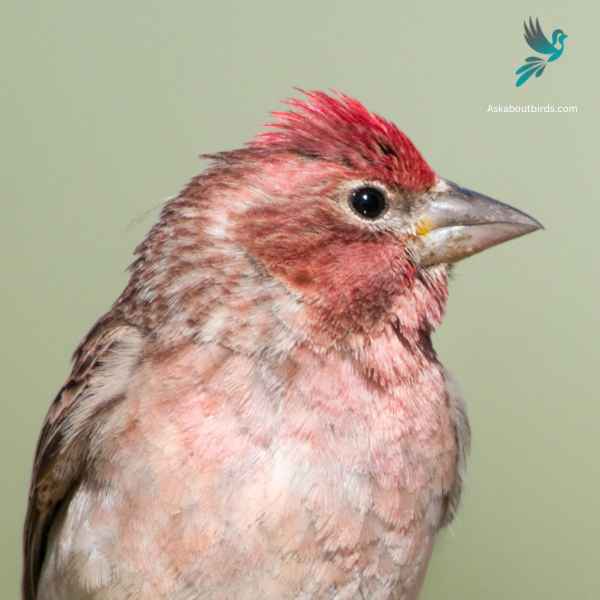
| Feature | Measurement |
|---|---|
| Scientific Name | Haemorhous cassinii |
| Length | 6.0-6.5 in |
| Wingspan | 9.5-10.5 in |
| Weight | 0.8-1.0 oz |
The Cassin’s Finch is a small songbird known for its melodic song and affinity for high-elevation forests.
Appearance: Male Cassin’s Finches are pinkish-red on the crown and throat, contrasting with their streaked brown back and wings. Females lack the bright coloring, appearing streaked brown throughout with a pale eyebrow stripe. Both sexes have a notched tail and a slightly curved bill.
Diet: Cassin’s Finches mainly feed on seeds, particularly from conifers. They also eat insects, especially during the breeding season. Their feeding habits often bring them to bird feeders where they readily eat sunflower seeds.
Reproduction: Cassin’s Finches nest in trees, preferring coniferous forests. The nest is made from twigs, grasses, and feathers. Typically, the female lays 3 to 5 eggs and handles most of the incubation. Both parents partake in feeding the fledglings once they hatch.
Pine Grosbeak

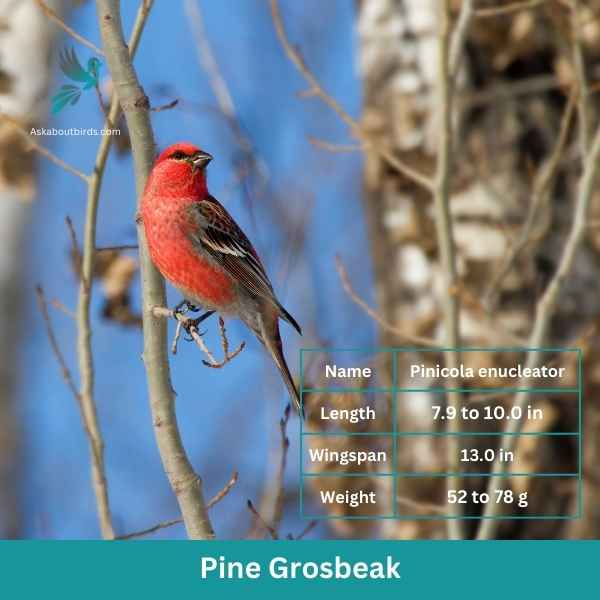
| Feature | Measurement |
|---|---|
| Scientific Name | Pinicola enucleator |
| Length | 7.9 to 10.0 in |
| Wingspan | 13.0 in |
| Weight | 52 to 78 g |
The Pine Grosbeak is a striking bird native to the northern regions of North America, often found in coniferous forests. Both males and females have a plump and robust body with a large beak adapted for eating seeds. The male Pine Grosbeak displays a vibrant reddish-pink plumage, while the female has a more subdued grayish-brown coloration.
These birds are typically seen in small flocks, foraging for food in trees and on the ground. They have a preference for seeds, particularly those from various conifer species. The Pine Grosbeak uses its strong bill to crack open the cones of tall trees and extract the seeds, but they also consume berries and small fruits when available.
Red Crossbill

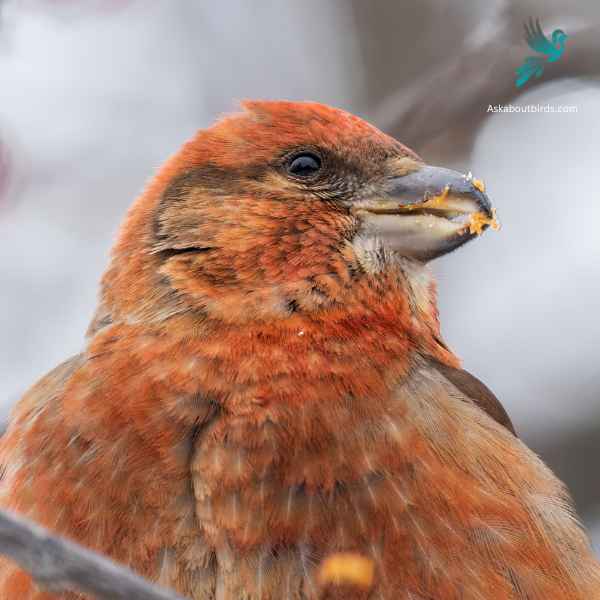
| Feature | Measurement |
|---|---|
| Scientific Name | Loxia curvirostra |
| Length | 5.5–7.5 in |
| Wingspan | 9.8–10.6 in |
| Weight | 0.9–1.4 oz |
The Red Crossbill is a distinctive finch known for its unusual bill, which has evolved to extract seeds from conifer cones.
Appearance: Males are typically bright red or orange, while females are greenish-yellow or olive. Both genders have the characteristic crossed bill, which they use to expertly extract seeds from tightly closed conifer cones.
Diet: Red Crossbills primarily feed on the seeds of coniferous trees, such as spruce, pine, and fir. Their specialized bills allow them to efficiently pry apart conifer cone scales to access the seeds.
Reproduction: Red Crossbills are somewhat nomadic and don’t adhere to a strict breeding schedule. Instead, they breed whenever and wherever food is abundant. Their nests are usually built on horizontal branches of conifer trees.
Rufous-sided (Eastern) Towhee
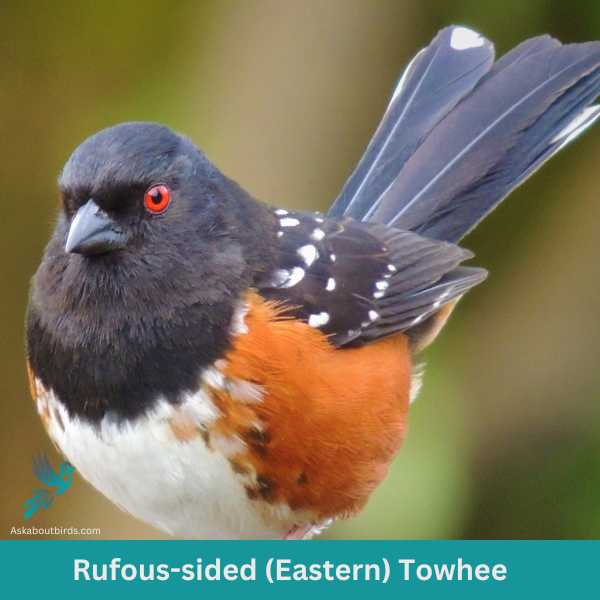
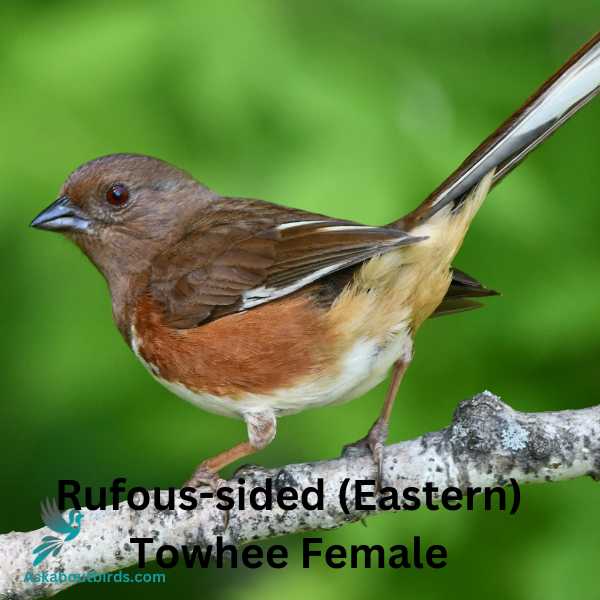
| Scientific Name | Pipilo erythrophthalmus |
| Length | 6.75 to 8.25 inches |
| Wingspan | 7.9 to 11 inches |
| Weight | 1.1 to 1.8 ounces |
The Rufous-sided Towhee, more commonly known as the Eastern Towhee, is a striking bird distinguished by its vivid coloration and melodious calls.
Appearance: Male Eastern Towhees are characterized by their black upper bodies, rufous flanks, and white underbellies. Females share the same pattern but are brown where the males are black. Both sexes have a distinctive red eye.
Diet: Eastern Towhees primarily feed on the ground, rummaging through leaf litter for seeds, berries, and insects. Their diet can vary seasonally, with more insects in warmer months and seeds during winter.
Reproduction: Eastern Towhees nest on or near the ground, typically in shrubs or dense vegetation. The female constructs the nest and incubates a clutch of 2 to 5 eggs, which hatch after about 12 days.
Red-Winged Blackbird
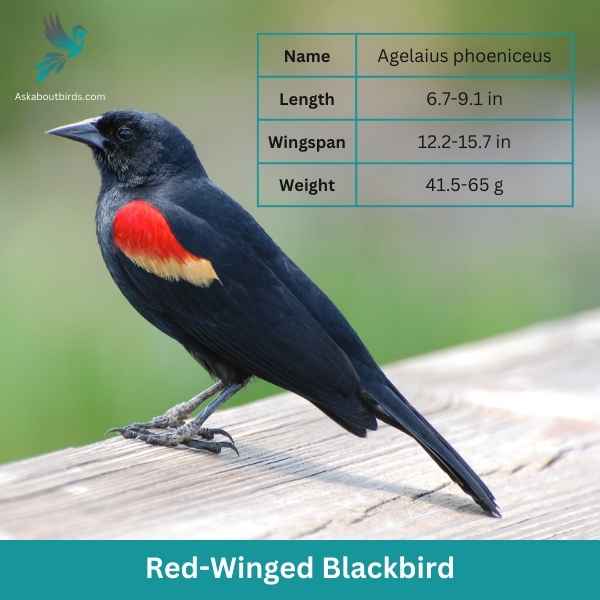
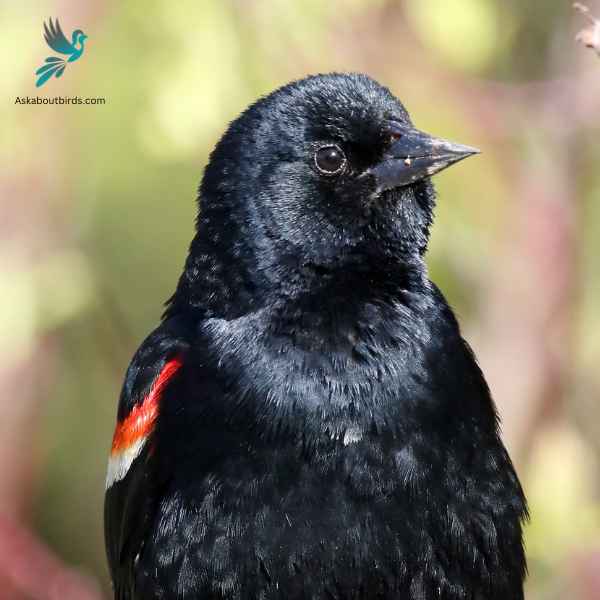
| Feature | Measurement |
|---|---|
| Scientific Name | Agelaius phoeniceus |
| Length | 6.7-9.1 in |
| Wingspan | 12.2-15.7 in |
| Weight | 41.5-65 g |
The Red-Winged Blackbird is a familiar sight across North America, especially in wetlands and open areas. Known for its striking coloration and distinct call, it is often seen perched on cattails or utility lines.
Appearance: Male Red-Winged Blackbirds are glossy black with bright red-and-yellow shoulder patches, while females are streaky brown, resembling a large sparrow. The males’ red patches become more prominent when they’re displaying or agitated.
Diet: Red-Winged Blackbirds primarily feed on seeds and insects. Their diet includes grains, sunflower seeds, and corn, but they also eat beetles, caterpillars, and other small invertebrates, especially in the breeding season.
Reproduction: Red-Winged Blackbirds nest in marshes, along watercourses, and in wet fields. The female constructs a cup-shaped nest using grass and sedge, attaching it to plants above water. She typically lays a clutch of 3 to 4 blue-green eggs, which she incubates for about 11-12 days. Males, being polygynous, often have multiple mates during a single breeding season.
Where to Spot Colorado’s Red Birds
The rich tapestry of Colorado’s landscapes offers some of the most enchanting birdwatching locales in the nation. Here are the top spots, revered by bird enthusiasts, where one can experience the state’s diverse avian wonders:
- Barr Lake State Park, Brighton: A premier birding spot, this park is home to over 350 bird species. Its tranquil waters and diverse habitats draw a myriad of waterfowl and migratory birds, including various red-feathered species.
- Rocky Mountain National Park: Spanning different altitudes and ecosystems, this national park is a haven for alpine species and montane birds. The varying elevations allow birdwatchers to experience a gradient of avian diversity.
- San Luis Valley: As a significant migratory pathway, this valley sees an influx of sandhill cranes, raptors, and songbirds. Its wetlands and vast expanses provide crucial habitats for both residents and visitors.
- Mesa Verde National Park: Apart from its archaeological wonders, Mesa Verde is also a hotspot for desert and plateau bird species. Its unique geography draws a variety of birds, making it a must-visit for enthusiasts.
- Pawnee National Grassland: Situated in the Eastern Plains, this grassland is a prime location for spotting grassland birds, raptors, and the occasional vagrant. The vast open spaces make for excellent birdwatching opportunities.
| State’s Red Birds | Best Spots for Red Birds |
|---|---|
| Wyoming’s Red Birds | 1. Yellowstone National Park 2. Seedskadee National Wildlife Refuge |
| Nebraska’s Red Birds | 1. Crescent Lake National Wildlife Refuge 2. Fontenelle Forest |
| Kansas’s Red Birds | 1. Quivira National Wildlife Refuge 2. Cheyenne Bottoms |
| Oklahoma’s Red Birds | 1. Wichita Mountains Wildlife Refuge 2. Oxley Nature Center |
| New Mexico’s Red Birds | 1. Bosque del Apache National Wildlife Refuge 2. Rattlesnake Springs |
| Arizona’s Red Birds | 1. Ramsey Canyon Preserve 2. Patagonia Lake State Park |
| Utah’s Red Birds | 1. Bear River Migratory Bird Refuge 2. Antelope Island State Park |
FAQs on Red Bird Species Found in Colorado
What are some of the bright red birds that can be spotted in Colorado?
In Colorado, bright red birds such as the adult male House Finches and male Pine Grosbeaks can be commonly observed. The male House Finches have bright red plumage, especially on their heads and chests, with two distinct white wing bars on their dark gray wings. Meanwhile, male Pine Grosbeaks are adorned with a red head, red plumage on their upper breast, and stand out in forest canopies and evergreen forests.
Which red bird with distinctive white features is common in Eastern Colorado?
The Red-headed Woodpecker, prevalent in Eastern Colorado, showcases a bright red head, large white wing patches, and white outer tail feathers. They often inhabit shade trees, city parks, and semi-open habitats, where they feed mostly on insects but can also be spotted searching for seeds in pine cones.
Are there any specific birds in Colorado with a penchant for pine cones?
Certainly! The White-winged Crossbills are particularly known for their affinity for pine cones. Found in evergreen forests and forest edges, these birds use their unique cross-tipped beaks to extract conifer seeds from the cones. Male White-winged Crossbills sport bright red plumage, distinguishing them from other birds.
Do Northern Flickers exhibit any red features, and where can they be seen in Colorado?
Yes, the Northern Flicker, commonly seen in Colorado, showcases a red crown or a shade of red on the back of their neck. These birds, which can often be spotted in city parks, forest canopies, and backyard feeders, exhibit white splotches on their black tail and tail coverts. Their distinct features, combined with their large size, make them easy to identify amidst other birds.




